Dee Estuary Birding
Monthly Newsletter...
February 2023 Newsletter
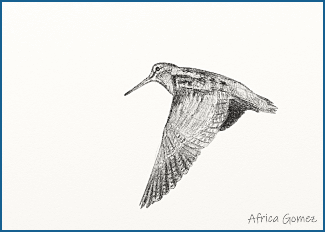
A Year at Meols - A Favourite Place

© Richard Smith
Writing last month's article on the bird paintings
along the "Wader's Walk" got me thinking about all the good bird
experiences I've had along Meols Shore over the years, including some
mega rarities found by others. Although it can be used as such this
isn't really a site guide, more a collection of highlights mostly from
the
past 20 years.
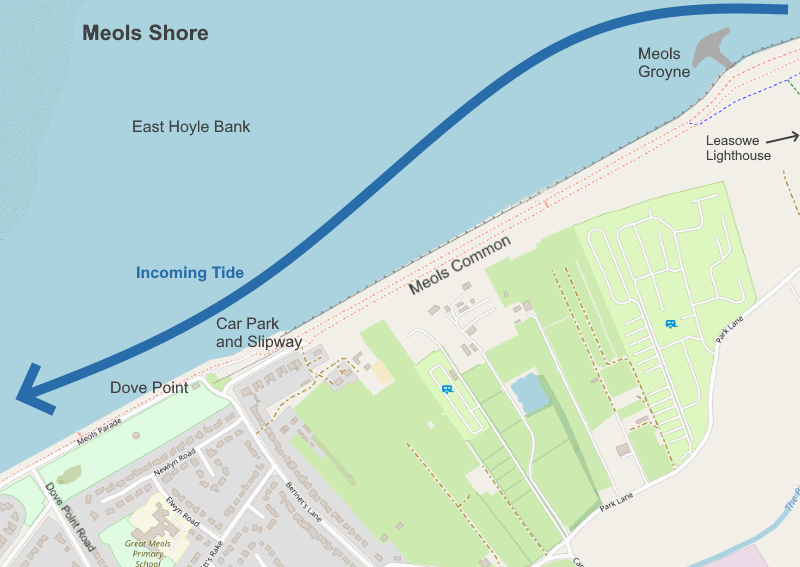
 Maps courtesy of www.openstreetmap.org
, annotated by Richard Smith.
Maps courtesy of www.openstreetmap.org
, annotated by Richard Smith.
Setting the Scene
The maps show Meols shore from the Meols/Leasowe
boundary to the north-east (top right) to the Hoylake/Meols boundary to
the south-west (bottom left) - Note that the Meols/Leasowe boundary is
at the groyne running inland, and the Hoylake Meols boundary runs
inland from about 100 feet north-east of the boating lake. The tide
comes in from the north-east along a channel from New Brighton
direction - this channel fills very quickly and you don't want to be on
the wrong side of it!
The shore between the Dove Point slipway and the
groyne is relatively sandy although you have to cross some quite thick
mud to get to it. Going south-west from Dove Point the shore is very
muddy and hence attractive to waders. Beyond the muddy area is East
Hoyle
Bank which turns sandy as you approach the sea at low tide. On
most days all this is covered by the sea at high tide, although on neap
high tides some of East Hoyle Bank remains uncovered and the birds use
it as
a roost site. All the landward side (Meols Promenade and the sea
defence) is raised up above the shore and gives good views over the sea
at high tide. The rising tide usually reaches Dove Point, along the
channel, two hours before high tide. The sea tends to spread out
here as it moves towards Hoylake forming a lagoon with many
waders and gulls feeding on the tide line.
I'll describe some highlights season by season, but with rarities grouped at the end - and there have been some megas over the years!
Summer
I start with what many birders regard as the start of the birding year - with the return of the birds after breeding.
By the end of June there is a sharp increase in gulls on the shore with Black-headed Gulls easily the most numerous. Colour ringing tells us that many of these Black-headed Gulls breed in the north-west of England but the same can't be said of the Mediterranean Gulls and they breed throughout the continent. In 2022 we saw a juvenile Med Gull in mid July which had still been in the breeding colony on the Atlantic coast of France at the end of June, and over the years we have seen ones which have bred in the Netherlands and Germany and as far east as Poland. As the tide floods the Med Gulls often feed or roost on the mud in front of the incoming tide, with the shore in front of Sandhey Slipway a favourite spot. At low tide a sizable gull roost can form on the sand to the west of the groyne and in July 2022 eight Med Gulls were counted there. Another gull species to look out for is Little Gull, they are scarce here in summer but the last two years a single adult has been recorded on the tide line in August, and close enough to get a decent photo. Other gull species are recorded here in smaller numbers, including Common Gulls.
Although we never get large numbers at Meols the
tideline in August is where you can good close views of terns, mostly
Sandwich at first then towards the end of the month there should be a
noticeable influx of Common Terns with a few Little, and occasionally
one or two Black Terns.
One of the joys of summer birding is seeing the waders in full breeding plumage. By the end of July Dunlins will be piling in and at this time of year we see the ones that have bred in Iceland and Greenland on their way to spend the winter in West Africa. Most of these will be of the schinzii race, but look out for the noticeably smaller arctica which only breed in north-east Greenland.
Although much smaller in number - Grey Plovers, Bar-tailed Godwits and Knot all look stunning at this time of year. Perhaps not as colourful, but juvenile waders always look so smart and 'brand new' and it's always good to see them as it means they have had a successful breeding season.
The Meols groyne is a magnet for birds, particularly at high tide. Notable recent summer records are 6 Common Sandpipers on July 19th 2021, 24 Little Egrets on August 24th 2022 and eight Wheatears on August 27th 2022.
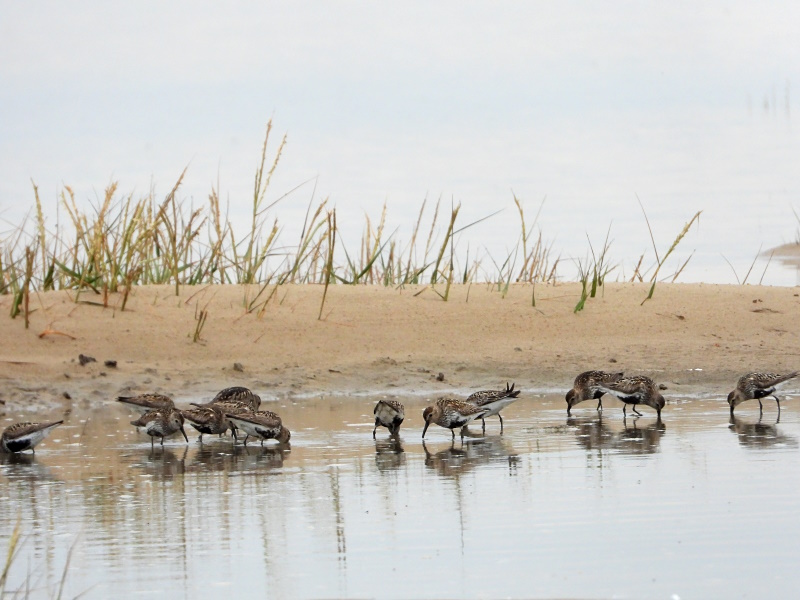
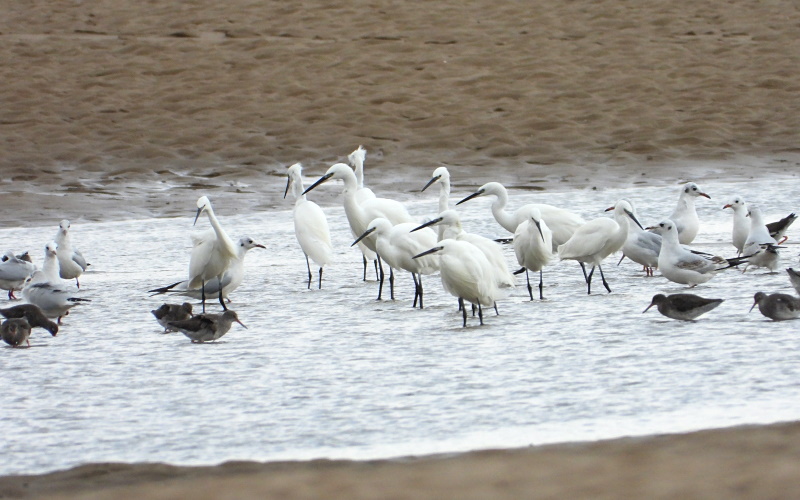
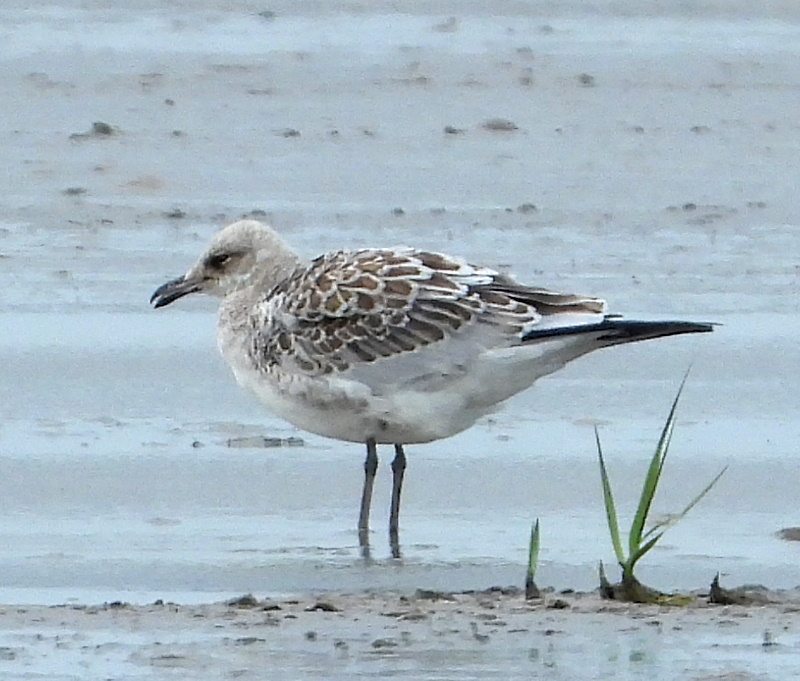
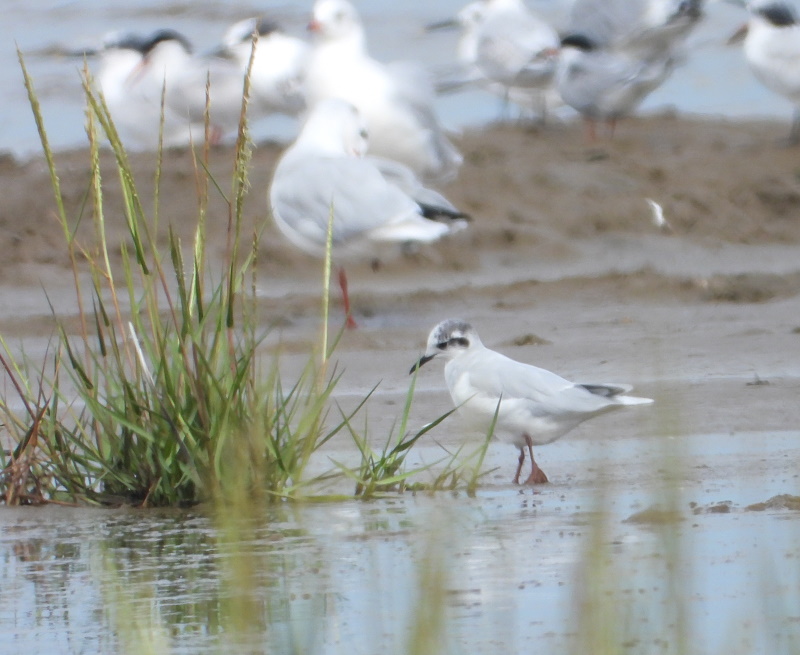
Autumn
The adjacent Hoylake shore is well known for it's high tide wader roost but it's not always realised that many of the waders, in particular the rare and scarce ones, often make their way to Meols as the tide drops - sometimes giving better views than at Hoylake. This certainly applies to Curlew Sandpipers and Little Stints in September and I well remember a couple of years ago standing on the shore by Dove Point when four Curlew Sandpipers dropped down beside me and started feeding. Little Stints and a good selection of other waders are probably best seen feeding in front of the incoming tide off Sandhey Slipway.
Oystercatchers are present all year but peak in the autumn. Several hundred can be seen feeding around the boats at Dove Point at low tide but a few thousand pass through before and after high tide between their roost site at Hoylake and the main feeding area off Leasowe. One thing I love seeing is 'the March of the Oystercatchers' which happens on every medium to spring high tide. As the tide starts to flood, coming up the channel, the Oystercatchers first gather in a large temporary roost on East Hoyle Bank off the groyne. They will then fly closer to the 'prom' and then all start walking in front of the tideline towards Hoylake. With their pink legs, black and white bodies and bright orange beaks it is really quite comical and impressive at the same time. It is also a good opportunity to look out for colour rings on those pink legs and we have seen birds ringed in Iceland, Norway, the Netherlands as well as several locations around the UK.
Autumn, of course, is when we expect, and hope for,
gales. Any prolonged north-west gale, particularly around
mid-September, will blow in Leach's Petrels as well as a selection of
skuas and other sea birds. It was Meols where I saw my first Leach's
Petrel in September 2001. It was high tide and blowing a gale (of
course) and I was in the shelter at the end of Roman Road. 16 flew past
in just over half an hour, no more than 100 yards out, and I've been
obsessed with them ever since! In 2010, which was the best Leach's year
this century, I stood on the slipway at Dove Point looking down the
north Wirral Coast towards New Brighton and I could see 10 flying
towards me in just one sweep of the 'scope. More recently, 2017 was
particularly good when a total of 36 were recorded past Dove Point on
September
11th.
Shelduck are very much a feature of Meols Shore. Not
so much because of large numbers but because of the great views they
give close to the promenade, drinking and bathing in the channel. Large
numbers are present on Dawpool Bank off Thurstaston in September and
early October after which they start to disperse and it's then we see
them at Meols with up to 300 on the mud through November.
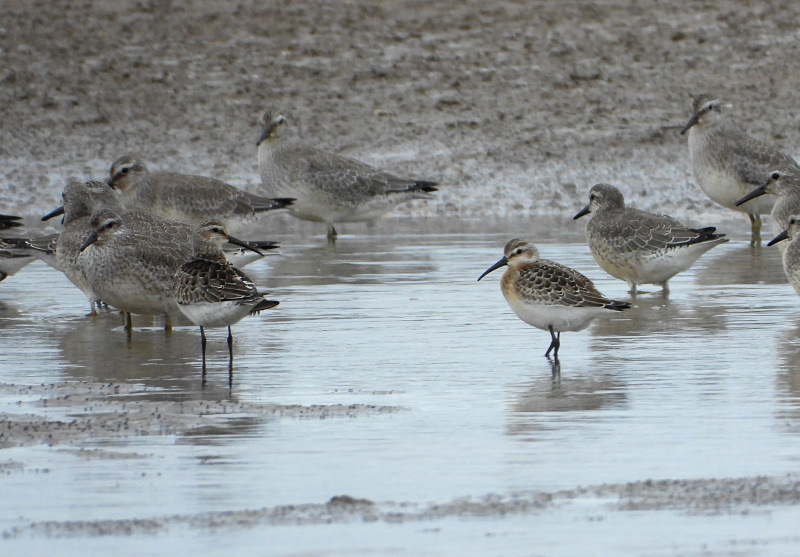

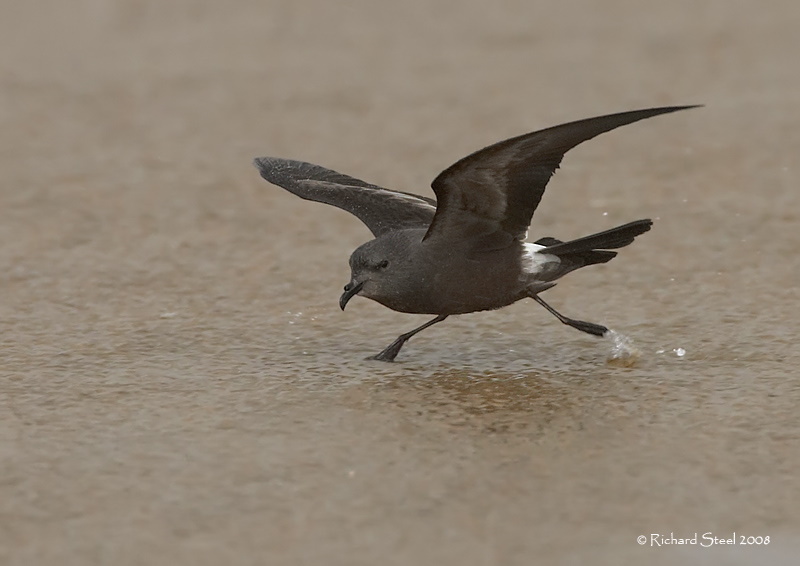
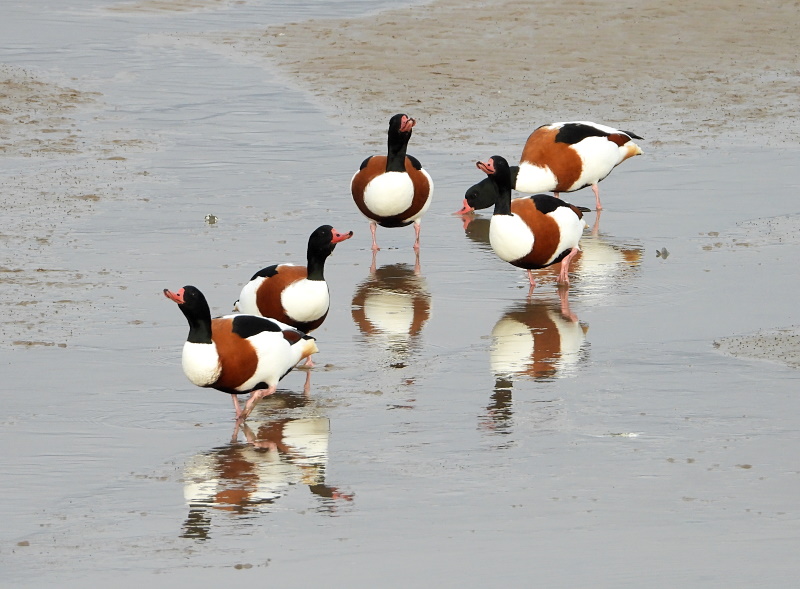
Winter
We get all the usual estuarine waders at Meols,
mostly feeding around the boats at Dove Point but also right up to the
Lifeboat Station. On most days this winter (2022/23) we have had
several hundred Dunlin feeding and Redshanks and Oystercatchers are
ever present, plus a few Turnstones on the seawall. But its the Knots I
love seeing and, as Knots tend to do, they come and go. They'll arrive,
perhaps a couple of thousand or so, either from the east having roosted
at Seaforth, or the west from Hoylake direction. They cover the mudflat
in tight flocks, moving in unison as they feed on small shellfish.
Having spent ten minutes in one spot they'll suddenly decide to move a
couple of hundred yards putting on a sychronised flying display as they
go. The most spectacular displays are put on when a Peregrine is
around, if the Peregrine attack is not too severe they'll come back but
often we see them disappear as fast as they can go! I spend many hours
down there scanning their legs for colour rings and the best views are
had when they start feeding on the sandy area to the east of Dove Point
as they can come really close to the seawall, and I've sometimes seen
them walking up the seawall just like Turnstones, with cyclists bombing
along the path just a few yards away.
The Meols groyne is used as a high tide roost by the
waders and great views can be had of Lapwings, Sanderlings, Dunlins,
Redshanks and Knots although numbers vary greatly from day to day. An
over-wintering Greenshank has been regular there for several
years, and this winter we've had two.
When the sea is flat calm take a look through your telescope and you will be amazed at the number of birds out there. Common Scoters are always present and numbers between 5,000 and 10,000 are not unusual, but occasionally we get much larger numbers. There was a huge flock of up to 40,000 in February 2016 stretching all along North Wirral, with a similar number in October that year. Just an amazing sight specially when they all take to the air!
On November 16th 2022 589 Great Crested Grebes were counted on the sea. But that was by no means the highest count with several over 800 over the years with the maximum a remarkable 1195 in January 2011. This was the total for the whole of North Wirral but whenever I've done counts the highest concentration has always been off Meols.
One of the most spectacular sights I've seen at
Meols was a huge gathering of gulls during February 2013. There were
several counts of 20,000 between Hilbre and New Brighton that month.
Mainly Herring Gulls but plenty of all the commoner gulls were present,
but on the 12th most of them were loafing on East Hoyle Bank on the
ebbing tide. I've never seen so many gulls in one place before or since!
On dry land Snow Buntings and Rock Pipits are often
seen along the Meols stretch. One or two Snow Buntings are seen most
winters on the sea defence/cycle path east of Dove Point, with the
winter of 2020/21 being particularly good when we had a flock of eight
at Hoylake which often wandered up to Meols.

A great opportunity to read colour rings!
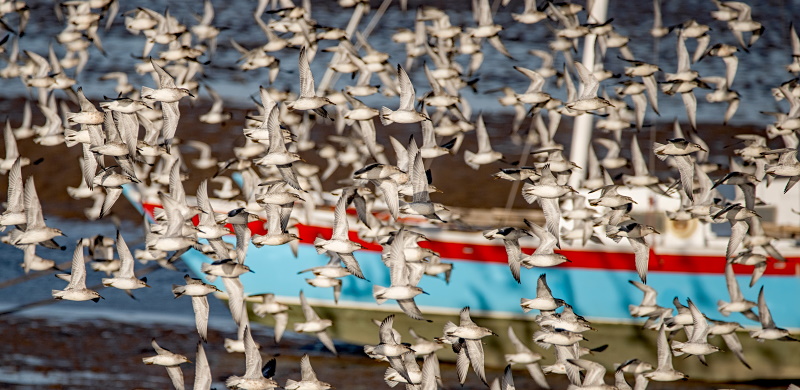
one spot to another giving great views from the sea wall, December 2022 © Ian Sheppard
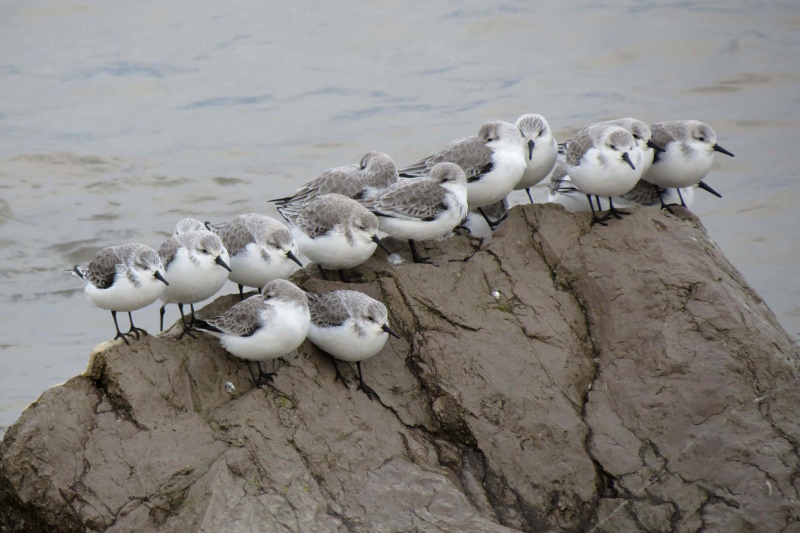
January 2014 © Les Hall
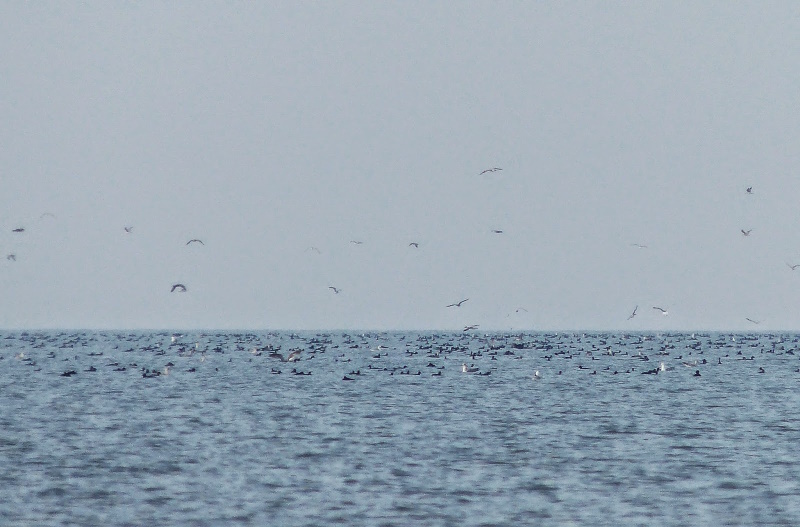
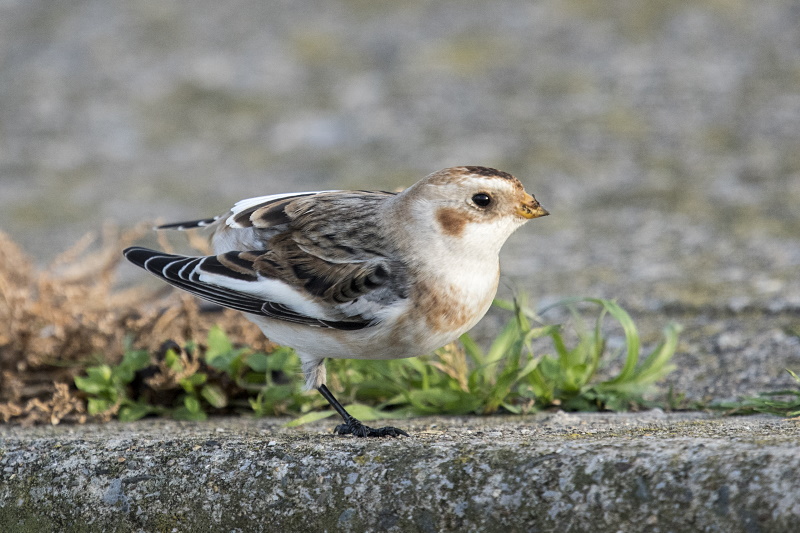
Spring
With plenty of northward movement, both on sea and
land, Spring is an exciting time at Meols and elsewhere along North
Wirral. In March and April there is a passage of Little Gulls which fly
up the Irish Sea before flying across the country on their way to breed
in the Baltic. They can be seen flying along the tideline on the edge
of East Hoyle Bank, identified by their small size and the distinctive
black under-wing.
Most years a few Ospreys are recorded flying over,
but they don't usually stay the night! One did just that on April 14th
2022, roosting in a tree overnight before landing on a post next to the
groyne the next morning until it decided to resume it's journey north.
April 12th last spring was particularly notable with the following all
seen between Dove Point and the groyne that day - 1 Great Egret in
gutter, 30+ Wheatear, 10+ Swallow, 1 House Martin, 2
Sand Martin, c20 Willow Warbler and c10 Chiffchaff. Other notable
records last spring where 10 White Wagtails on the shore on April 27th,
six Arctic Terns off the groyne May 4th and a summer plumaged Curlew
Sandpiper with Dunlin on the groyne on May 17th. By early May the Knots
will be in full breeding plumage but we rarely see these birds as they
tend to stay up at Ainsdale and Southport before flying off across the
Atlantic. But in 2021 a flock of around 1,000 fed up on Meols Shore
looking lovely and red, and the presence of several Grey Plovers in the
flock, also in full summer plumage, helped to make for a spectacular
sight.
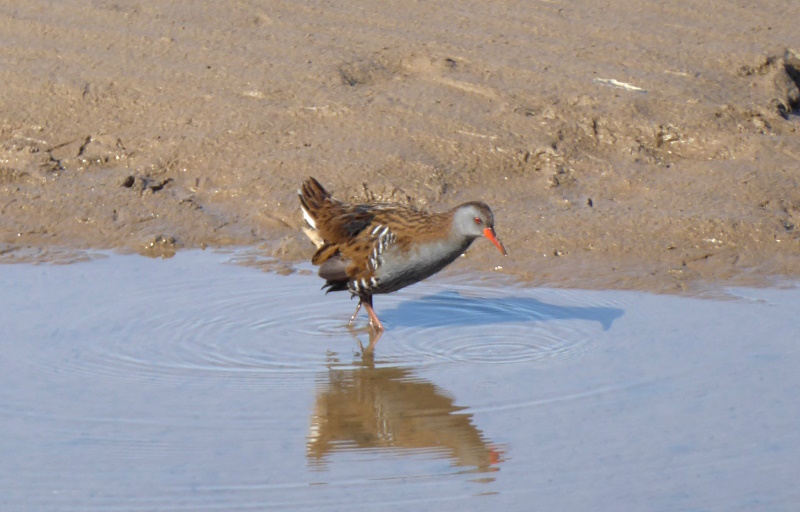
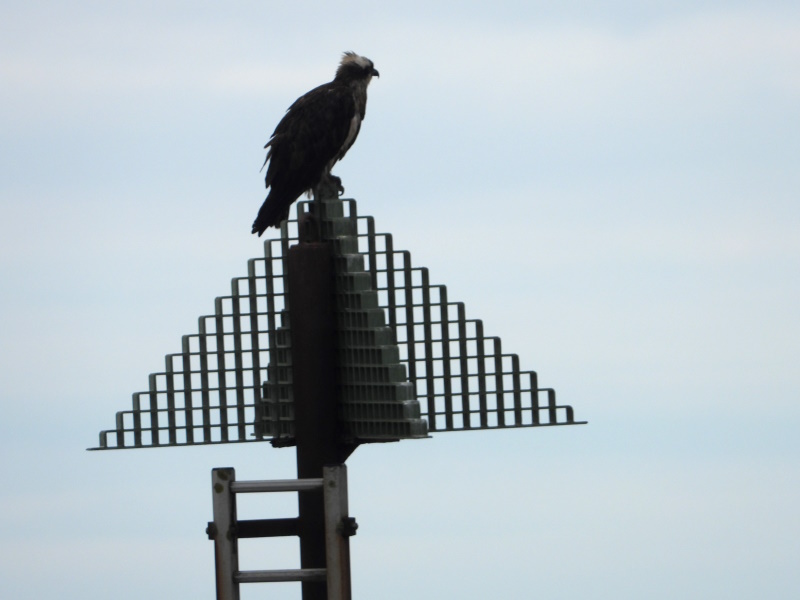
The following morning it landed on this navigation post next to the groyne © Richard Smith
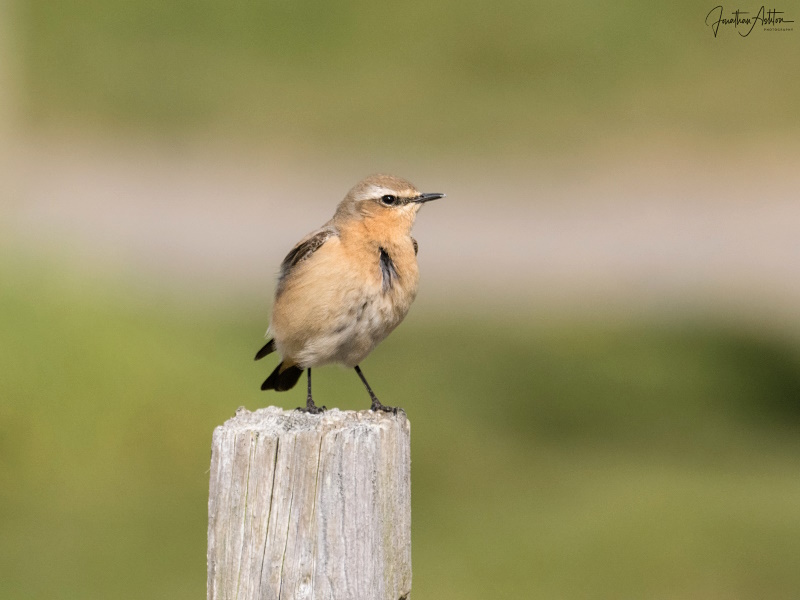
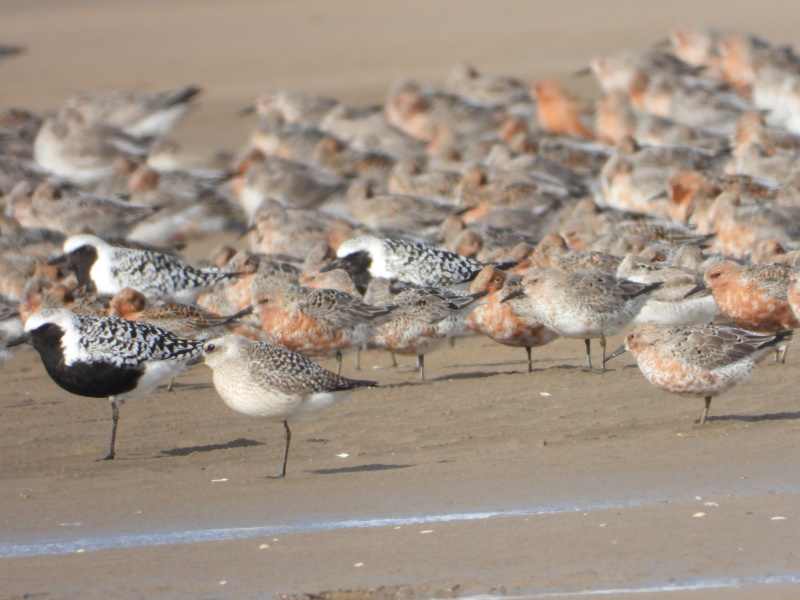
These were off Dove Point in early May 2021 © Richard Smith
Rarities
For the most celebrated rarity at Meols we have to go back to October 1979 when an Asian Desert Warbler was found in the sand dunes just east of Dove Point. At the time it was only the fourth British record and it resulted in a large twitch.
There is a horse paddock just inland of the sand
dunes on Meols Common which is still called 'Hoopoe hollow' after
a Hoopoe which was present there for several days in April 2004. I
remember
it well as it gave excellent views.
Two waders, initially seen at Hoylake and then relocated at Meols, were a Broad-billed Sandpiper in May 2011 and a Western Sandpiper in September 2012. The latter was initially thought by many to be a Semipalmated Sandpiper and was the cause of much debate, but the BBRC agreed with the finder (Allan Conlin) that it was a Western Sandpiper.
An unexpected rarity was a Green-winged Teal in a
flock of Teal (themselves a rarity at Meols) seen at Dove Point on
April 4th 2014.
An Alpine Swift flew over Park Lane on April 22nd 2015. Also at Park Lane that year was a Red-backed Shrike on September 4th and 5th.
Three summer plumaged Dotterels were in a Dunlin
flock on the mud on May 3rd 2015.
During September gales it is not unusual to spot a Grey Phalarope or two from Meols, but on September 16th 2017 one landed on the groyne to join the sheltering waders.
A Pied Wheatear was a nice find sitting on top of the sea wall at Dove Point, it showed well for three days in early November 2018. Although not a rarity as such a Black Redstart was in the exact same spot, also showing really well, in October 2020.
Arctic Skuas are not unusual off Meols in the summer
and autumn but Pomarine Skuas are much rarer. Unusually an adult
decided to fly over Meols town on September 26th 2019 before landing on
Meols Shore not far from the promenade.
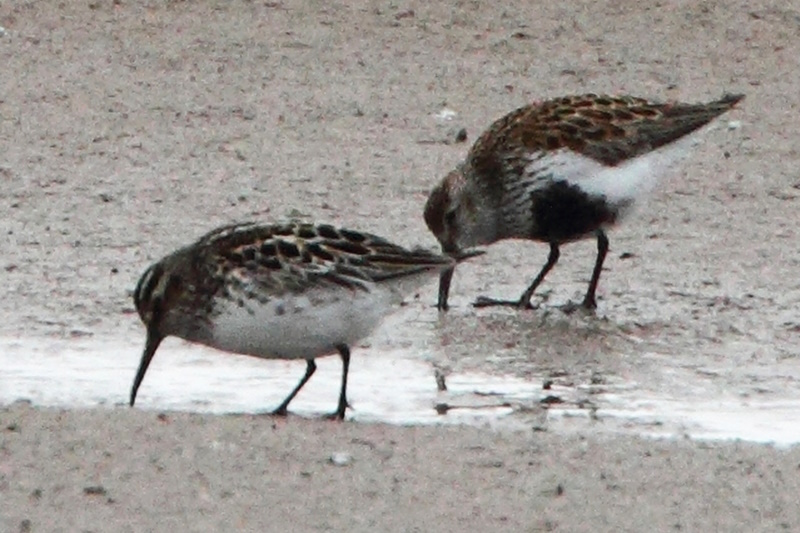

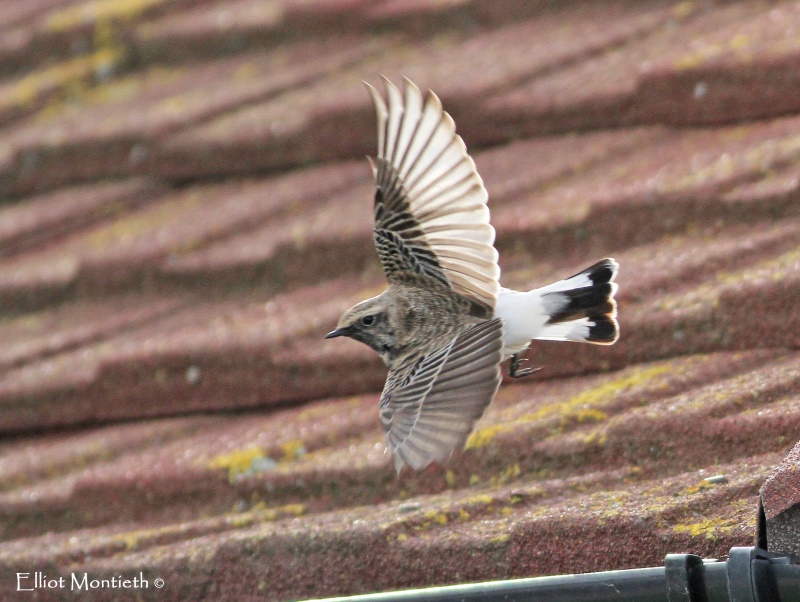

Richard Smith
Colour Ring Report
Grey Plovers

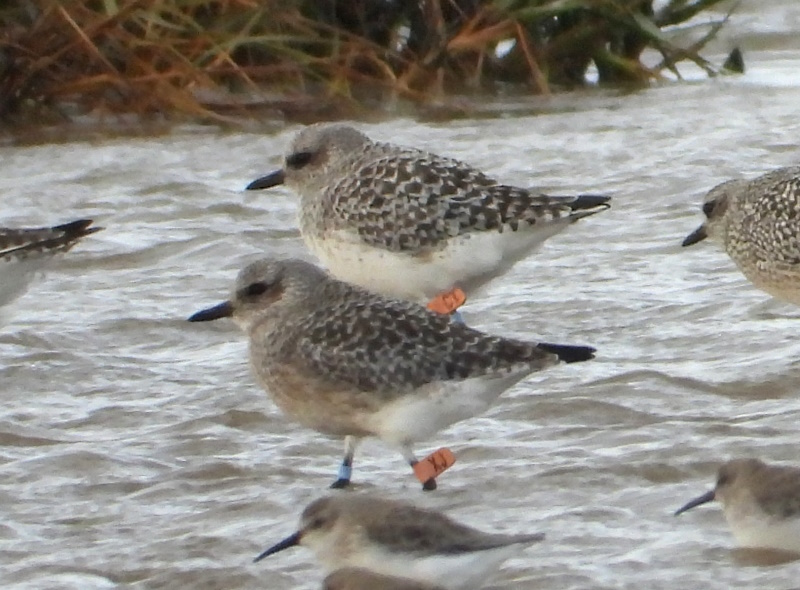
This winter has proved particularly productive for
colour ringed Grey Plover with 38 sightings of 24 different birds.
These are ones that were ringed over by the Alt Estuary in 2018 and
2019, and they all have orange flags. Some nice high tide roosts at
Hoylake, largely undisturbed, brought the Grey Plovers close to the
shore and with their long legs the flags could be read even when they
are
standing in water.
The movements of Grey Plovers has
not been extensively studied so this colour ring scheme is helping to
fill in the gaps in our knowledge. So far the vast majority of records
have been around Liverpool Bay, particularly during autumn, early
winter and spring - suggesting that some go further south during
mid-winter
winter and there have been some sightings in Brittany.
Brent Goose
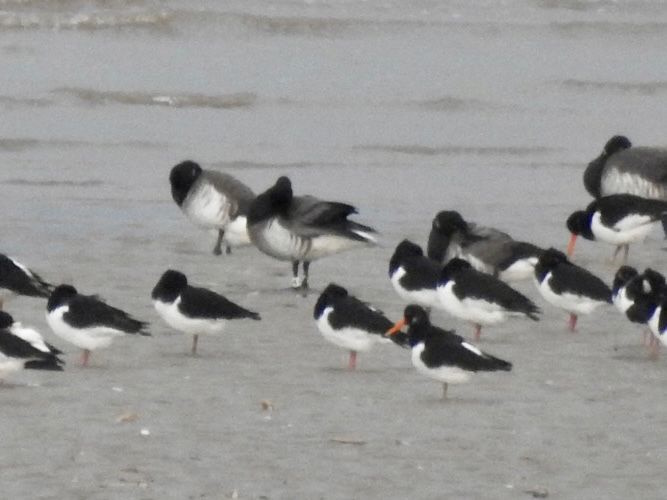
Brent Goose '74NW'
was ringed on Anglesey in February 2019.
It was one of a pair that was ringed and they were recorded at
Strangford Lough on September 26th 2019. They were first recorded on
Hilbre on October 31st 2019 with six juveniles in tow.
Rock Pipit

This Rock Pipit has been seen and photographed several times this winter, including by Mark Woodhead.
I quote from Mark's email to me "I photographed it on the sea wall West of New Brighton on 20th December 2022 and again 5th January 2023. Between Steve Williams and myself we have managed to decipher the ring number from multiple photos taken from different angles as '2637635'. This means that Steve ringed it on Hilbre on 22 September 2022 as a 3 (juvenile)".
Great work!
Mediterranean Gull
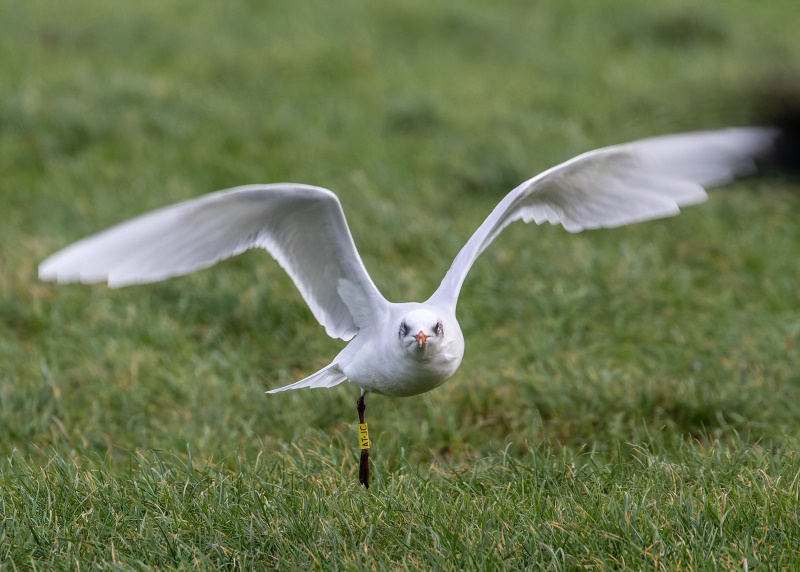
Yellow Ring AT.JC
Ringed near Luckow, Germany, on 06/06/2021, as a breeding adult.
Recorded at Seaforth six times between August 2021 and March 2022.
It returned to Seaforth in July 2022 before being seen at Egremont in
October 2022 and Crosby in December 2022.
Recorded at Leasowe on 04/01/2023.
Black-headed Gull
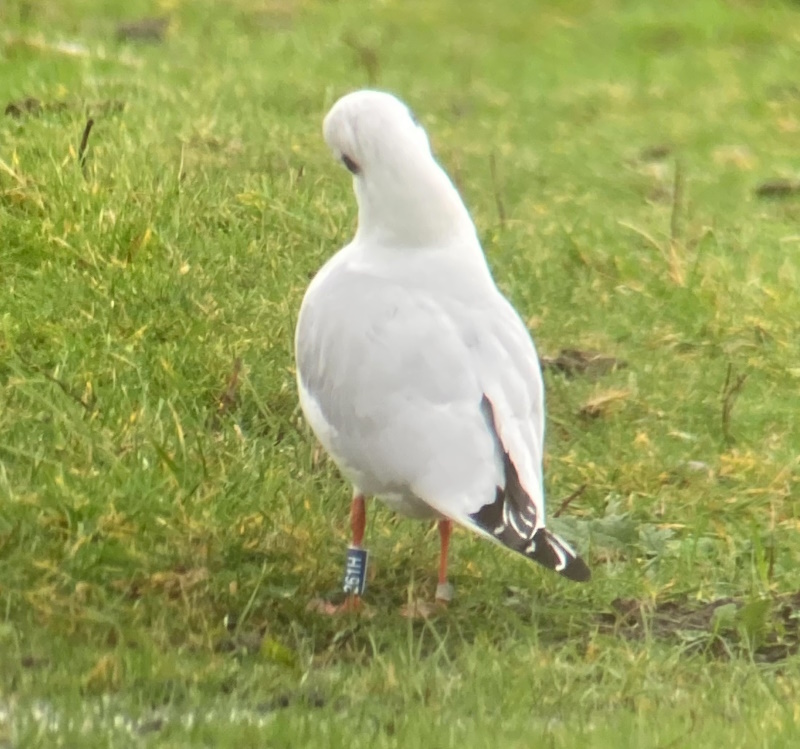
Blue Ring 261H
Ringed at Sefton Park, Liverpool, on 01/12/2022.
Recorded on Kerr's Field, Leasowe, on 05/01/2023.
It was one of several ringed by the Waterbird Colour-marking Group at Sefton Park.
Colour Rings were recorded by Richard Smith, Stephen
Hinde, Alan Hitchmough, Tony
Ormond, Sean O'Hara, Peter Sutton, Steve Williams, Mark Woodhead, Helen
Jones, Eddie Williams, Tim Kinch, John Sharp, Roy Lowry, Charles
Farnell and Colin Schofield.
Richard Smith
December and January Bird News

There have been some spectacular high tide wader roosts at Hoylake this winter and I've been pleasantly surprised at how little disturbance there has been - at least when I've been down there. In particular there have been large numbers of Dunlin and the highest count at Hoylake I made was 22,500 on January 22nd, compared to the five year average of 16,900 for the whole estuary (BTO WeBS).
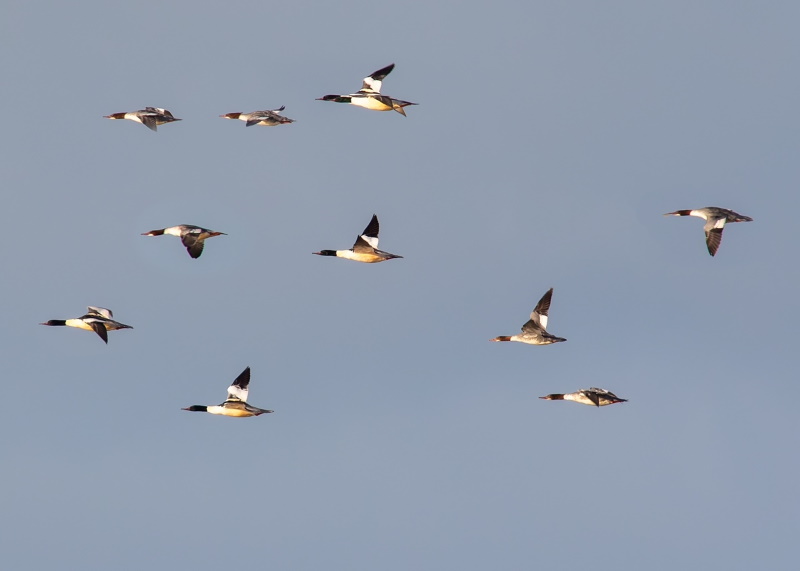
A Black Guillemot on the sea off Hoylake was a nice
record on December 1st, they are way less than annual in our area and
this is just the sixth one we've had since 2010. Also out there were a
flock of six Long-tailed Ducks which arrived in early December and
seemed to have stayed all winter. Several Velvet Scoters have been seen
with the thousands of Common Scoters (max 15,000 on January 4th) and
the highest Great Crested Grebe count for these two months was 334 on
January 22nd. At Hilbre up to four Eiders have been around the island.
During the cold spell in December numbers of Goosanders on West Kirby
Marine Lake seemed to be increasing every day with a maximum of 36 on
the 14th - a record high number, 20 in December 2021 was previous
highest
count. Also during the cold spell a roost of Woodcocks was discovered
near Ditton Lane, Moreton. These flew out at dusk towards the fields at
Leasowe with up to 12 counted.
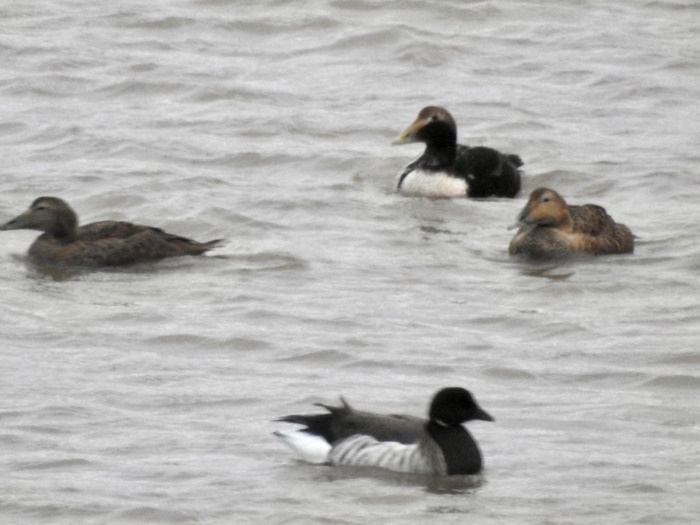
On the marshes a Bittern has been seen regularly flying into the roost
at Parkgate, as have at least 20 Marsh Harriers. Those sort of Marsh
Harrier numbers are almost routine at Parkgate and Neston but five at
Gronant in early January was more unexpected. Hen Harrier numbers have
been low this winter but it was good to have two grey males.
Short-eared Owl numbers have also been low but three
were spotted towards the end of January a long way out on the marshes.
These days Pink-footed Geese are everywhere but over 6,000 leaving
their roost at Hoylake Marsh at first light was an awe inspiring sight
through January - and many flew over my house in Caldy on their way to
feed in the fields between Hoylake and Greasby.
Strong winds on January 9th resulted in a really
good seawatch off hoylake with almost 1,000 auks, including two
Puffins, 15 Gannets, 275 Kittiwakes and a blueish Fulmar.
A Long-billed Dowitcher briefly visited Burton Mere
Wetlands on January 11th. Small flocks of Whooper Swans visited or flew
over BMW and 27 were on Shotwick Fields in January.
A Snow Bunting has spent several weeks on the shore
and sand dunes at Derby Pool, Wallasey, and at least 25 Twite have been
on the marsh next to Flint Castle.
An intriguing record was a probable Dartford Warbler
near Burton Point on January 29th. There was a brief view and a poor
photograph taken, there was also a report of a second sighting later on
that day but no photograph or description has emerged.
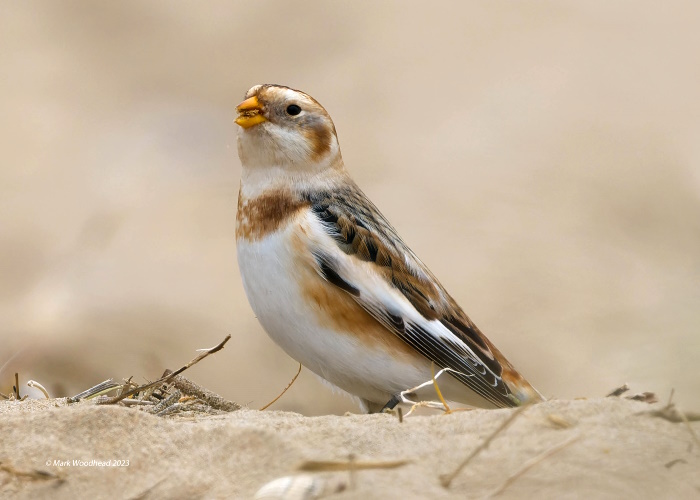
What to expect in February
Over the past few years we've had at least two severe gales in February, bringing massive storm surges of at least 1.5 metres. If we get a repeat expect to have some spectacular birding at Parkgate with thousands of wildfowl and waders in the air, as well as Hen Harriers, Marsh Harriers and Short-eared Owls. Out to sea strong winds often bring Little Gulls closer to the coast, these will probably be birds which over-winter in the Irish sea but maybe already moving north-westwards towards their breeding grounds.
There are some big high tides due this month, if
they coincide with a westerly gale that should be interesting!
Signs of the coming spring will include the usual
passage of Stonechats along north Wirral, the return of Avocets to
Burton Mere Wetlands and Mediterranean Gulls moulting into summer
plumage.
Top of Page
Forthcoming Events
February Highest Spring Tides (Liverpool)
Also see Tides page.
20th February, 11.08hrs (GMT), 9.8m.
21st February, 11.53hrs (GMT), 10.1m.
22nd February, 12.36hrs (GMT), 10.2m.
23rd February, 13.17hrs (GMT), 10.1m.
24th February, 13.57hrs (GMT), 9.7m.
Forthcoming Events

Also see events at https://events.rspb.org.uk/deeestuary